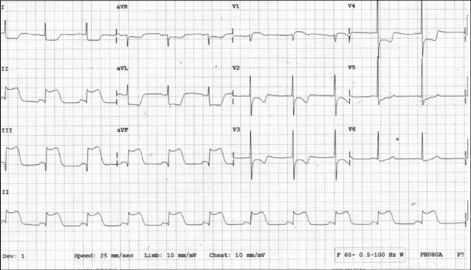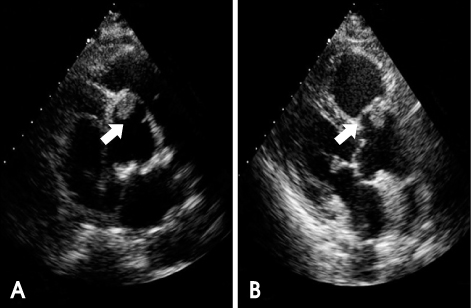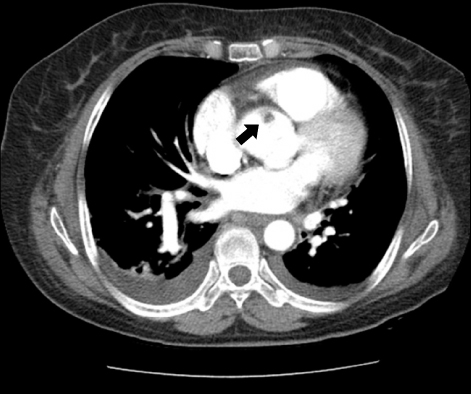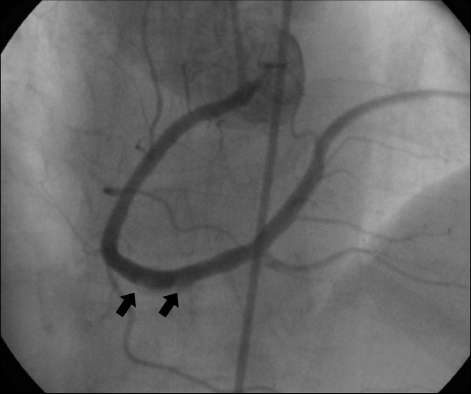J Cardiovasc Ultrasound.
2008 Sep;16(3):102-104. 10.4250/jcu.2008.16.3.102.
ST-Segment Elevation Acute Myocardial Infarction Secondary to Native Aortic Valve Thrombus
- Affiliations
-
- 1Division of Cardiology, Department of Internal Medicine, Chungju ST. Mary's Hospital, Cheongju, Korea. fastangio@naver.com
- KMID: 1486589
- DOI: http://doi.org/10.4250/jcu.2008.16.3.102
Abstract
- Native aortic valve thrombosis is a very rare condition. We report a case of ST-segment elevation acute myocardial infarction secondary to native aortic valve thrombus in a 61-year-old woman who presented with acute chest pain. The patient had no previous precipitating factors. The patient was treated with a thrombolytic agent and subsequently recovered. On a follow-up echocardiogram, the thrombus of aortic valve disappeared.
Keyword
MeSH Terms
Figure
Reference
-
1. Jones CB, Draughn T, Nomeir AM. Aortic valve thrombus presenting as a Non-ST elevation myocardial infarction. J Am Soc Echocardiogr. 2008. 1:e1–e3.
Article2. Hamilton RM, Penkoske PA, Byrne P, Duncan NF. Spontaneous aortic thrombosis in a neonate presenting as coarctation. Ann Thorac Surg. 1988. 45:564–565.
Article3. Freeman RV, Crittenden G, Otto C. Acquired aortic stenosis. Expert Rev Cardiovasc Ther. 2004. 2:107–116.
Article4. Warner JG, Rupard LL, Davis GJ, Lantz PE, Nomeir AM. Aortic valve thrombus first seen as inferior myocardial infarction in a patient with polycythemia. Am Heart J. 1994. 127:1407–1411.
Article5. Jobic Y, Provst K, Larlte JM, Mondine P, Gilard M, Boschat J, Blanc JJ. Intermittent left coronary occlusion caused by native aortic valve thrombosis in a patient with protein S deficiency. J Am Soc Echocardiogr. 1999. 12:1114–1116.
Article6. Grondin F, Giannoccaro JP. Antiphospholipid antibody syndrome associated with large aortic valve vegetation and stroke. Can J Cardiol. 1995. 11:133–135.7. Wan S, DeSmet JM, Vincent JL, LeClerc JL. Thrombus formation on a calcific and severely stenotic bicuspid aortic valve. Ann Thorac Surg. 1997. 64:535–536.
Article8. Cho SJ, Yang JH, Shin JU, Uhm E, Lee SC, Park SW, Park PW. A case of spontaneous native aortic valvular thrombosis that caused aortic stenoinsufficiency in the bicuspid aortic valve. Kor Circ J. 2006. 36:666–668.
Article9. Stein PD, Sabbah HN, Pitha JV. Continuing disease process of calcific aortic stenosis: role of microthrombi and turbulent flow. Am J Cardiol. 1977. 39:159–163.10. Rhee KS. A case of papillary fibroelastoma of the left ventricular outflow tract causing stroke. J Kor Soc Echo. 2004. 12:42–44.
Article
- Full Text Links
- Actions
-
Cited
- CITED
-
- Close
- Share
- Similar articles
-
- ST segment
- Acute Myocardial Infarction by Right Coronary Artery Occlusion Presenting as Precordial ST Elevation on Electrocardiography
- Clinical Features of Acute Aortic Dissection Patients Initially Diagnosed with ST-segment Elevation Myocardial Infarction
- Differences in Clinical Outcomes Between Patients With ST-Elevation Versus Non-ST-Elevation Acute Myocardial Infarction in Korea
- Acute Proximal Aortic Dissection Associated with ST Segment Elevation on Electrocardiography






